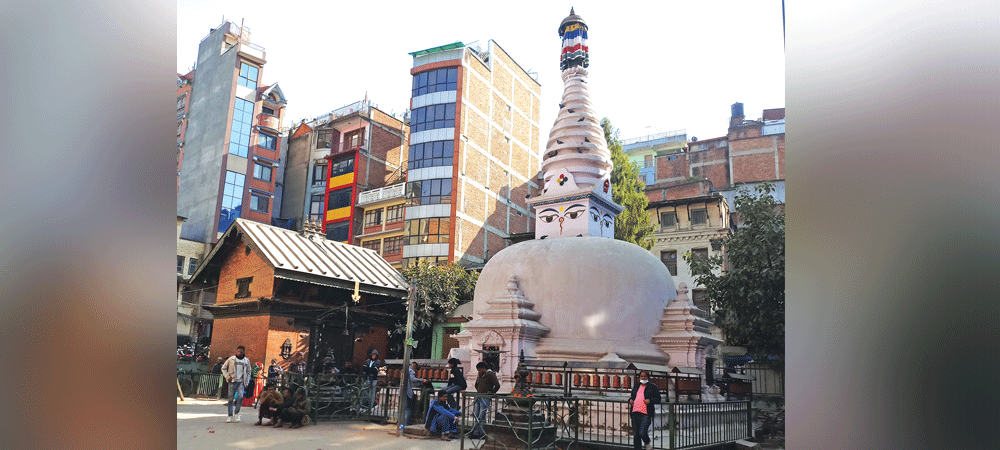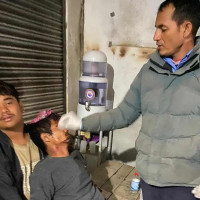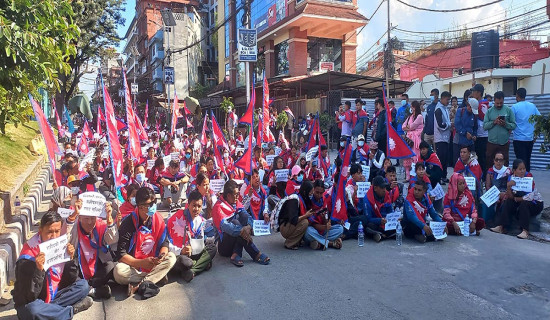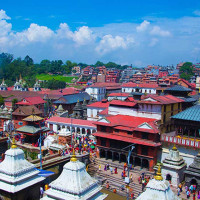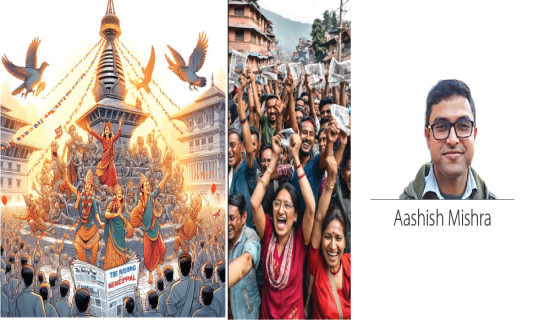- Saturday, 25 October 2025
The place we know and the monastery we don’t
Kathmandu, Dec. 2: A short distance west of the Bir Hospital, under the shadow of the tall buildings and drowned by the din of the circumambient market and the vehicles parked all around lies the Lichhavi-era Ukuma Mahavihar.
Occupying one and a half Ropanis of land in the metaphorical heart of the capital in Kathmandu Metropolitan City–30, the Mahavihar is a gem hidden in plain sight that is impossible for anyone passing through to not see.
The statues of four Buddhas – Amitabha, Akshobhya, Amoghasiddhi and Ratnasambhava – and five Taras engirdling a 30-foot white Dharmadhatu stupa, a bright red temple with a golden roof and a religious shelter for the preservation of the consecrated fire, there are too many things in the monastery complex, whose name indicates it to be a special cenobium, for the eyes to miss.
“People definitely know of this place. They just know it by a different name,” said local Shrabin Tuladhar. “Many know the Vihar and the neighbourhood as Mahabouddha.”
For the sake of simplicity and public understanding, the Shakya trust that looks after the monastery has also co-opted this name and calls it the Mahabuddha Mahavihar. The Guthi, which comprises five local Shakya families, accordingly styles itself the Mahabuddha Vihar Shakya Guthi and has Sangha Ratna Shakya as its elder patriarch.
And according to Shakya, Mahabuddha holds the unique dichotomy of being an inconspicuous landmark that everyone knows without knowing.
Case in point, very few know that in a temple east of the lime-plastered stupa, the Mahavihar houses a statue of Akshobhya Buddha that is claimed to be the tallest in the country. “Including its seat, the statue is 15 feet tall and depicts the Buddha (Kwa: Pa: Dya) in a Bhumisparsha (land-touching) position,” Shakya shared. The statue is also unusually red.
Idolatry representations of Akshobhya Buddhas are usually blue. “But it is intriguing that this particular one is red,” he said. The Rising Nepal asked a dozen shopkeepers who said they had been based in Mahabouddha for more than five years if they knew the Mahavihar held such an exceptional figure. All except one said no.
To be fair though, it could be because no one except the initiated members of the five Shakya families is allowed inside the Kwa: Pa: Dya’s sanctum.
Nevertheless, this perceived lack of awareness has led Guthi head Shakya to prepare a leaflet detailing the history and significance of this 1,500-year-old centre that also goes by the name Mahabuddha Bahal. As per that leaflet, Ukuma Mahavihar was built in 512 AD by Ravigupta, a powerful official in the court of King Basanta Dev, grandson of Mandev. It took him 20 years to build this monastery and to give it a form that has since been lost to time.
“Extensive reconstructions and renovations have been carried out over the years. So, the Vihar we have today is not the same as the one Ravigupta constructed,” Shakya elucidated.
Originally, the monastery had an 18-inch wall around its perimeter. But it collapsed and by the 1960s, the area was an open field. This enabled the then Kathmandu Nagar Panchayat to encroach upon the monastery’s space and build shop shutters to its north and west in 1965. This diminished the monastery’s religious ambience and the community had to struggle to get those structures demolished.
The brochure credits nurse Bidyawati Kansakar as having led the fight against the insensitive local government and having later fenced the area at her own cost.
“At present too, we have to stay vigilant to keep the street vendors and wayward drivers seeking to park their vehicles out,” Shakya complained.
Furthermore, the monastery’s stupa needs to be repaired. The 2015 earthquake cracked its mound and tilted its finial. Shakya informed that the Guthi has coordinated with the Kathmandu Metro and the Department of Archaeology to begin repairs but work has not started.
“It is hard when you have to do everything alone.”
The Mahabuddha Shakya Guthi is the sole body looking after the Vihar and its member families arrange all the necessary funds out of their own pockets. The Mahavihar supposedly had land in various places once upon a time but there are no records of them today.
But that does not deter Shakya or the Guthi. “We are doing the best we can and plan to do more,” he said proudly. “But it indeed is hard to do everything alone.”

